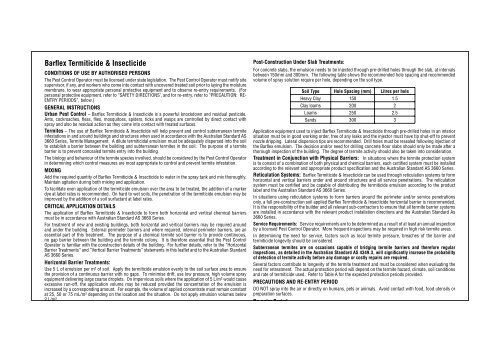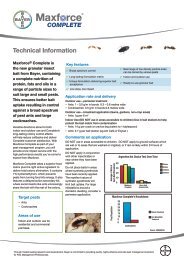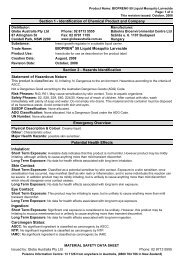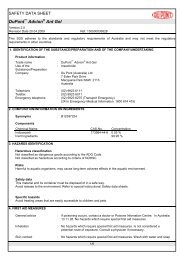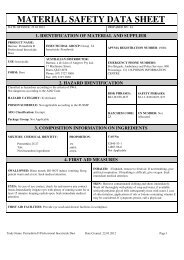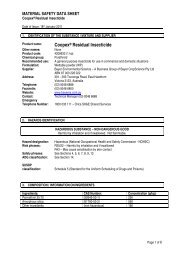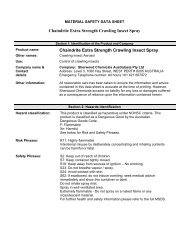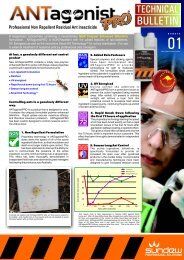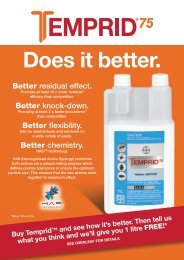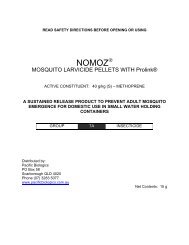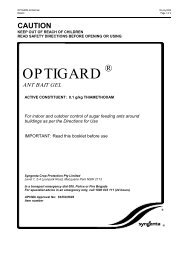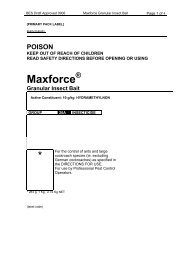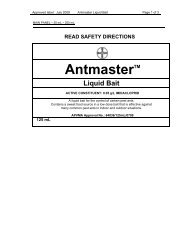Label - Globe Australia
Label - Globe Australia
Label - Globe Australia
You also want an ePaper? Increase the reach of your titles
YUMPU automatically turns print PDFs into web optimized ePapers that Google loves.
Barflex Termiticide & Insecticide<br />
CONDITIONS OF USE BY AUTHORISED PERSONS<br />
The Pest Control Operator must be licensed under state legislation. The Pest Control Operator must notify site<br />
supervisor, if any, and workers who come into contact with uncovered treated soil prior to laying the moisture<br />
membrane, to wear appropriate personal protective equipment and to observe re-entry requirements. (For<br />
personal protective equipment, refer to “SAFETY DIRECTIONS’, and for re-entry, refer to “PRECAUTION: RE-<br />
ENTRY PERIODS”, below.)<br />
GENERAL INSTRUCTIONS<br />
Urban Pest Control – Barflex Termiticide & Insecticide is a powerful knockdown and residual pesticide.<br />
Ants, cockroaches, fleas, flies, mosquitoes, spiders, ticks and wasps are controlled by direct contact with<br />
spray and also be residual action as they come into contact with treated surfaces.<br />
Termites – The use of Barflex Termiticide & Insecticide will help prevent and control subterranean termite<br />
infestations in and around buildings and structures when used in accordance with the <strong>Australia</strong>n Standard AS<br />
3660 Series, Termite Management. A dilute termiticidal emulsion must be adequately dispersed into the soil<br />
to establish a barrier between the building and subterranean termites in the soil. The purpose of a termite<br />
barrier is to prevent concealed termite entry into the building.<br />
The biology and behaviour of the termite species involved, should be considered by the Pest Control Operator<br />
in determining which control measures are most appropriate to control and prevent termite infestation.<br />
MIXING<br />
Add the required quantity of Barflex Termiticide & Insecticide to water in the spray tank and mix thoroughly.<br />
Maintain agitation during both mixing and application.<br />
To facilitate even application of the termiticide emulsion over the area to be treated, the addition of a marker<br />
dye at label rates is recommended. On hard to wet soils, the penetration of the termiticide emulsion may be<br />
improved by the addition of a soil surfactant at label rates.<br />
CRITICAL APPLICATION DETAILS<br />
The application of Barflex Termiticide & Insecticide to form both horizontal and vertical chemical barriers<br />
must be in accordance with <strong>Australia</strong>n Standard AS 3660 Series.<br />
For treatment of new and existing buildings, both horizontal and vertical barriers may be required around<br />
and under the building. External perimeter barriers and where required, internal perimeter barriers, are an<br />
essential part of this treatment. The purpose of a chemical termite soil barrier is to provide continuous,<br />
no gap barrier between the building and the termite colony. It is therefore essential that the Pest Control<br />
Operator is familiar with the construction details of the building. For further details, refer to the “Horizontal<br />
Barrier Treatments” and “Vertical Barrier Treatments” statements in this leaflet and to the <strong>Australia</strong>n Standard<br />
AS 3660 Series.<br />
Horizontal Barrier Treatments:<br />
Use 5 L of emulsion per m² of soil. Apply the termiticide emulsion evenly to the soil surface area to ensure<br />
the provision of a continuous barrier with no gaps. To minimise drift, use low pressure, high volume spray<br />
equipment delivering large coarse droplets. On impervious soils where the application of 5 L/m² would cause<br />
excessive run-off, the application volume may be reduced provided the concentration of the emulsion is<br />
increased by a corresponding amount. For example, the volume of applied concentrate must remain constant<br />
at 25, 50 or 75 mL/m² depending on the location and the situation. Do not apply emulsion volumes below<br />
2 L/m².<br />
In situations where the soil surface is very dry and conditions are conducive to rapid drying, the area to be<br />
Post-Construction Under Slab Treatments:<br />
For concrete slabs, the emulsion needs to be injected through pre-drilled holes through the slab, at intervals<br />
between 150mm and 300mm. The following table shows the recommended hole spacing and recommended<br />
volume of spray solution require per hole, depending on the soil type.<br />
Soil Type Hole Spacing (mm) Litres per hole<br />
Heavy Clay 150 1.5<br />
Clay loams 200 2<br />
Loams 250 2.5<br />
Sands 300 3<br />
Application equipment used to inject Barflex Termiticide & Insecticide through pre-drilled holes in an interior<br />
situation must be in good working order, free of any leaks and the injector must have tip shut-off to prevent<br />
nozzle dripping. Lateral dispersion tips are recommended. Drill holes must be resealed following injection of<br />
the Barflex emulsion. The decision and/or need for drilling concrete floor slabs should only be made after a<br />
thorough inspection of the building. The degree of termite activity should also be taken into consideration.<br />
Treatment in Conjunction with Physical Barriers: In situations where the termite protection system<br />
is to consist of a combination of both physical and chemical barriers, each certified system must be installed<br />
according to the relevant and appropriate product specification and the <strong>Australia</strong>n Standard AS 3660 Series.<br />
Reticulation Systems: Barflex Termiticide & Insecticide can be used through reticulation systems to form<br />
horizontal and vertical barriers under and around structures and all service penetrations. The reticulation<br />
system must be certified and be capable of distributing the termiticide emulsion according to the product<br />
label and the <strong>Australia</strong>n Standard AS 3660 Series.<br />
In situations using reticulation systems to form barriers around the perimeter and/or service penetrations<br />
only, a full pre-construction soil applied Barflex Termiticide & Insecticide horizontal barrier is recommended.<br />
It is the responsibility of the builder and all relevant sub-contractors to ensure that all termite barrier systems<br />
are installed in accordance with the relevant product installation directions and the <strong>Australia</strong>n Standard As<br />
3660 Series.<br />
Service Requirements: Service requirements are to be determined as a result of at least an annual inspection<br />
by a licensed Pest Control Operator. More frequent inspections may be required in high risk termite areas.<br />
In determining the need for service, factors such as local termite pressure, breaches of the barrier and<br />
termiticide longevity should be considered.<br />
Subterranean termites are on occasions capable of bridging termite barriers and therefore regular<br />
inspections, as detailed in the <strong>Australia</strong>n Standard AS 4349.3, will significantly increase the probability<br />
of detection of termite activity before any damage or costly repairs are required.<br />
Several factors contribute to longevity of the termite treatment and must be considered when evaluating the<br />
need for retreatment. The actual protection period will depend on the termite hazard, climate, soil conditions<br />
and rate of termiticide used. Refer to Table A for the expected protection periods provided.<br />
PRECAUTIONS AND RE-ENTRY PERIOD<br />
DO NOT spray into the air or directly on humans, pets or animals. Avoid contact with food, food utensils or<br />
preparation surfaces.<br />
Re-entry Period<br />
Pre-Construction: Re-entry – Do not allow entry into uncovered treated areas until the spray has dried. When


